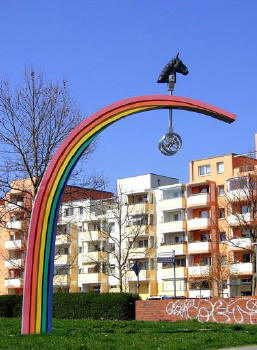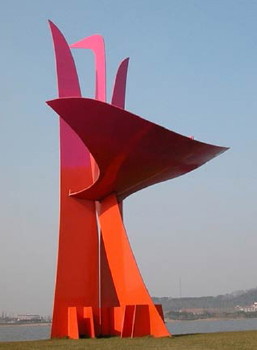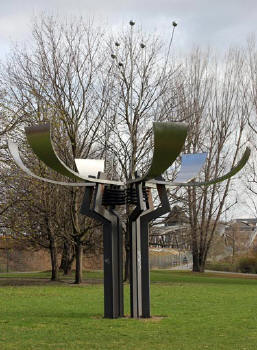Artist:
Herman Makkink
Title:
De Vlindermolen
Year:
1998
Adress:
Anderlechtlaan
Waarom staat dit kunstwerk zo scheef?
Ik voel dat ik welkom geheten word door iets dat het midden houdt tussen een tol, een vestingtoren, een vrolijk konijn, een windmolen.
Als ik de Vlindermolen van Herman Makkink zie, weet ik dat ik er weer ben, dat ik de wijk binnenrijdt. Als ik over de rotonde rijdt denk ik aan een tol die langzamer draait en alle kanten op begint te tuimelen.
De basis wordt gevormd door een gemetselde schaal. Het ruwe metselwerk geeft een stevige geaarde basis. De schaal zorgt ervoor dat het kunstwerk kan draaien en kantelen of zelfs gevaarlijk ver kan overhellen. De basis zorgt voor aarding maar ook voor dynamiek.
Bij de rieten romp kan ik alleen aan een molen denken. Dit oer-Hollandse werktuig kunnen wij nu alleen maar zien als sieraad in het landschap. Dit maakt dat dit kunstwerk een baken is, een herkenningspunt voor de wijk.
Herman Makkink speelt met de vier wieken van een molen; de vormen zijn zo aangepast dat het oren kunnen zijn van een konijn. De oren zijn voorzichtig luisterend. Maar wat zijn de wieken die naar beneden hangen? Zouden dit bloembladen kunnen zijn?
Dit kunstwerk tolt van ideeën, prikkelt mijn fantasie en maakt mij vrolijk.
Door Theo, www.artatsite.com
Translation
Why is this work of art so awry?
I feel a welcome gesture by something that is halfway between a toll, a fortified tower, a merry rabbit, a windmill.
When I see the Vlindermolen by Herman Makkink, I know I’m back again, that I enter the district. When I turn on the roundabout, I think of a toll that turns slower and begins to tumble to all sides.
The basis is formed by a masonry bowl. The rough masonry gives a solid grounded basis. The bowl ensures the artwork is capable to rotate and tilt or even lean out dangerously.
By the reed trunk I can only think to a mill. This typically Dutch tool is now for us an ornament in the landscape. This makes the sculpture a piece of art, a beacon, a landmark for the district. Herman Makkink plays with the four blades of a mill; the shapes are adjusted like ears of a rabbit. The ears are careful listening. But what are the blades which hang down? Would this be petals?
This artwork lt turning and rotating ideas, tickles my imagination and makes me happy.
By Theo, www.artatsite.com
Vergelijking met andere kunstwerken
Het kunstwerk Steckenpferd träumt mit dem Regenbogen van Ruediger Jan Roehl (Berlijn, foto 1,meer informatie) is duidelijker leesbaar en in alle opzichten een grap.
Het kunstwerk Seventy Two Silent Propagations van Youngho Kim (Shanghai, foto 2,meer informatie) is net als de Vlindermolen een uitzonderlijk kunstwerk: grappig en raadselachtig.
Het kunstwerk Bird of Paradise van Dina Merhav (Shanghai, foto 3,meer informatie) is evenals de Vlindermolen een bijzonder herkenningspunt: groot met luchtige betekenissen.
Het werk Klingende Blume van Achim Kühn (Berlijn, foto 4,meer informatie) is een voorbeeld van een soort welkomsgebaar zoals je die vaak ziet; groot en dan ofwel sympatiek ofwel ernstig.
Door Theo, www.artatsite.com
Compared with other artworks
The artwork Steckenpferd träumt mit dem Regenbogen by Ruediger Jan Roehl (Berlin, picture 1, more information) is clearly readable and a joke altogether.
The artwork Seventy Two Silent propagations by Youngho Kim (Shanghai, picture 2, more information) is just like the Butterfly Mill an exceptional work: funny and puzzling.
The artwork Bird of Paradise by Dina Merhav (Shanghai, picture 3, more information) is, like the Butterfly Mill a special landmark: large and flighty meanings.
The work Klingende Blume Achim Kühn (Berlin, photo 4,more information) is an common example of a kindly gesture of welcome; big and then either sympathetic or serious.
By Theo, www.artatsite.com
Aspects of this artwork
Shape
The artwork is everything at once: a mill, a spinning top, a rabbit.
Material
The thatched roof and masonry are perfectly executed but zinc seems sloppy made without clear plans. The shaft is straight and yet it is completely skewed. The materials are natural and tactile.
Location
The sculpture stands on a roundabout. Friend and foe can not avoid it. Figuratively, because the work attracts attention and literally because the roundabout is one of the few access to the district. The work is so peculiar that opinions about it are probably strongly divided.
Impact
The impact is different for everyone and on every visit.
Meaning
A good work of art evokes emotion and a significance that is relevant in the context. This is exactly what the work does. When leaving or returning home, it is often good to be inspired by new ideas or become out of focus. The problem is that this is not recognized by everyone because of an overdose of meanings.
By Theo, www.artatsite.com
www.buitenbeeldinbeeld.nl:
Het kunstwerk op de rotonde is een herkenningsteken voor de zich steeds uitbreidende wijk en combineert een basis in de vorm van een halve gemetselde bol, een 'middengedeelte' dat refereert aan de vorm van oude molens en daar bovenop de vorm van een vlinder die op de sculptuur lijkt te zijn neergestreken.
Metselwerk speelt een belangrijke rol in het werk van Herman Makkink. Het materiaal keert steeds terug, in de vorm van bollen, cilinders en koepels. Aan de Lelylaan staat een klein bakstenen huisje en op de Spinozahof stond destijds de sculptuur 'Oude Grond', een buisvorm van wit betonsteen en rode baksteen. Het is in 1994 gesloopt omdat het volgens buurtbewoners het uitzicht beperkte. Ook de vlindermolen bestaat voor een deel uit metselwerk en de schuin staande gemetselde halve bol komt terug in een beeld dat in het Westerpark geplaatst is (2003).
Het gebruik van metselwerk heeft zijn oorsprong in Makkinks interesse voor resten van oude culturen. Zijn beeldtaal verwijst vaak naar ruïnes, waarvan de vreemde, niet direct te plaatsen vormen sterk contrasteren met de directe omgeving.
www.dorpsraadslotenoudosdorp.nl:
Makkink kreeg veel opdrachten voor kunstwerken in de openbare ruimte. Veel ervan zijn uitgevoerd in baksteen, zoals de Vlindermolen in Sloten. Het is in 1998 op de rotonde in de Sloterweg gebouwd en refereert aan de molens die vroeger in de omgeving stonden. De basis van dit opmerkelijke bouwwerk, bestaat uit een halve gemetselde bol met daarboven een rieten molenvorm. Bovenop deze 'molen' is als het ware een vlinder neergestreken. Deze vlindervorm kan ook gezien worden als afgeknotte molenwieken, waardoor het moleneffect nog versterkt wordt.
www.saevisundis.blogspot.nl:
Bij de kruising met de Anderlechtlaan staat in de rotonde de Vlindermolen (1998) van Herman Makkink. Heel oneerbiedig"De Peer" genoemd in de omgeving.
www.wikipedia.org:
Herman Makkink (Winschoten, 1937 – Amsterdam, 20 oktober 2013) was een Nederlandse beeldhouwer, graficus en tekenaar.
Translation
www.buitenbeeldinbeeld.nl:
The artwork on the roundabout is an identifier for the ever expanding area and combines a base in the form of a half-brick bol, a ' middle section ' referring to the form of old mills and on top of the shape of a butterfly on the sculpture seems to have settled down.
masonry plays an important role in the work of Herman M. The material returns again and again, in the form of spheres, cylinders and domes. To the Lelylaan is a small brick cottage and on the Ground at the time the sculpture was ' old Spinozahof ', a tube form of white concrete stone and red brick. It is demolished in 1994 because it limited the view according to local residents. Also the butterfly mill consists in part of masonry and sloping masonry hemisphere comes back in an image that is placed in the westerpark (2003).
the use of masonry has its origins in Makkinks interest in remains of ancient cultures. His visual language often refers to ruins, whose strange, not directly to post forms strongly contrast with the immediate vicinity.
www.dorpsraadslotenoudosdorp.nl:
Herman Makking got many commissions for works of art in public space. Many of them are made of brick, like the butterfly mill in Locks. It is built on a roundabout in the Sloterweg in 1998 and refers to the mills that once stood in the area. The base of this remarkable edifice, consists of a globe surmounted by a thatched half brick mill form. On top of these ' mill ' is, as it were, a butterfly settled down. This Butterfly shape can also be seen as truncated mill blades, making the mill effect is enhanced.
www.saevisundis.blogspot.nl:
At the junction with the anderlechtlaan State in the roundabout, take the Butterfly mill (1998) by Herman M. Very irreverent"The PEAR" mentioned in the environment.
www.wikipedia.org:
Herman Makkink (Winschoten, 1937 – October 20, 2013, Amsterdam) was a Dutch sculptor, printmaker and draughtsman.
Ik voel dat ik welkom geheten word door iets dat het midden houdt tussen een tol, een vestingtoren, een vrolijk konijn, een windmolen.
Als ik de Vlindermolen van Herman Makkink zie, weet ik dat ik er weer ben, dat ik de wijk binnenrijdt. Als ik over de rotonde rijdt denk ik aan een tol die langzamer draait en alle kanten op begint te tuimelen.
De basis wordt gevormd door een gemetselde schaal. Het ruwe metselwerk geeft een stevige geaarde basis. De schaal zorgt ervoor dat het kunstwerk kan draaien en kantelen of zelfs gevaarlijk ver kan overhellen. De basis zorgt voor aarding maar ook voor dynamiek.
Bij de rieten romp kan ik alleen aan een molen denken. Dit oer-Hollandse werktuig kunnen wij nu alleen maar zien als sieraad in het landschap. Dit maakt dat dit kunstwerk een baken is, een herkenningspunt voor de wijk.
Herman Makkink speelt met de vier wieken van een molen; de vormen zijn zo aangepast dat het oren kunnen zijn van een konijn. De oren zijn voorzichtig luisterend. Maar wat zijn de wieken die naar beneden hangen? Zouden dit bloembladen kunnen zijn?
Dit kunstwerk tolt van ideeën, prikkelt mijn fantasie en maakt mij vrolijk.
Door Theo, www.artatsite.com
Translation
Why is this work of art so awry?
I feel a welcome gesture by something that is halfway between a toll, a fortified tower, a merry rabbit, a windmill.
When I see the Vlindermolen by Herman Makkink, I know I’m back again, that I enter the district. When I turn on the roundabout, I think of a toll that turns slower and begins to tumble to all sides.
The basis is formed by a masonry bowl. The rough masonry gives a solid grounded basis. The bowl ensures the artwork is capable to rotate and tilt or even lean out dangerously.
By the reed trunk I can only think to a mill. This typically Dutch tool is now for us an ornament in the landscape. This makes the sculpture a piece of art, a beacon, a landmark for the district. Herman Makkink plays with the four blades of a mill; the shapes are adjusted like ears of a rabbit. The ears are careful listening. But what are the blades which hang down? Would this be petals?
This artwork lt turning and rotating ideas, tickles my imagination and makes me happy.
By Theo, www.artatsite.com
Vergelijking met andere kunstwerken
Het kunstwerk Steckenpferd träumt mit dem Regenbogen van Ruediger Jan Roehl (Berlijn, foto 1,meer informatie) is duidelijker leesbaar en in alle opzichten een grap.
Het kunstwerk Seventy Two Silent Propagations van Youngho Kim (Shanghai, foto 2,meer informatie) is net als de Vlindermolen een uitzonderlijk kunstwerk: grappig en raadselachtig.
Het kunstwerk Bird of Paradise van Dina Merhav (Shanghai, foto 3,meer informatie) is evenals de Vlindermolen een bijzonder herkenningspunt: groot met luchtige betekenissen.
Het werk Klingende Blume van Achim Kühn (Berlijn, foto 4,meer informatie) is een voorbeeld van een soort welkomsgebaar zoals je die vaak ziet; groot en dan ofwel sympatiek ofwel ernstig.
Door Theo, www.artatsite.com
Compared with other artworks
The artwork Steckenpferd träumt mit dem Regenbogen by Ruediger Jan Roehl (Berlin, picture 1, more information) is clearly readable and a joke altogether.
The artwork Seventy Two Silent propagations by Youngho Kim (Shanghai, picture 2, more information) is just like the Butterfly Mill an exceptional work: funny and puzzling.
The artwork Bird of Paradise by Dina Merhav (Shanghai, picture 3, more information) is, like the Butterfly Mill a special landmark: large and flighty meanings.
The work Klingende Blume Achim Kühn (Berlin, photo 4,more information) is an common example of a kindly gesture of welcome; big and then either sympathetic or serious.
By Theo, www.artatsite.com
Aspects of this artwork
Shape
The artwork is everything at once: a mill, a spinning top, a rabbit.
Material
The thatched roof and masonry are perfectly executed but zinc seems sloppy made without clear plans. The shaft is straight and yet it is completely skewed. The materials are natural and tactile.
Location
The sculpture stands on a roundabout. Friend and foe can not avoid it. Figuratively, because the work attracts attention and literally because the roundabout is one of the few access to the district. The work is so peculiar that opinions about it are probably strongly divided.
Impact
The impact is different for everyone and on every visit.
Meaning
A good work of art evokes emotion and a significance that is relevant in the context. This is exactly what the work does. When leaving or returning home, it is often good to be inspired by new ideas or become out of focus. The problem is that this is not recognized by everyone because of an overdose of meanings.
By Theo, www.artatsite.com
www.buitenbeeldinbeeld.nl:
Het kunstwerk op de rotonde is een herkenningsteken voor de zich steeds uitbreidende wijk en combineert een basis in de vorm van een halve gemetselde bol, een 'middengedeelte' dat refereert aan de vorm van oude molens en daar bovenop de vorm van een vlinder die op de sculptuur lijkt te zijn neergestreken.
Metselwerk speelt een belangrijke rol in het werk van Herman Makkink. Het materiaal keert steeds terug, in de vorm van bollen, cilinders en koepels. Aan de Lelylaan staat een klein bakstenen huisje en op de Spinozahof stond destijds de sculptuur 'Oude Grond', een buisvorm van wit betonsteen en rode baksteen. Het is in 1994 gesloopt omdat het volgens buurtbewoners het uitzicht beperkte. Ook de vlindermolen bestaat voor een deel uit metselwerk en de schuin staande gemetselde halve bol komt terug in een beeld dat in het Westerpark geplaatst is (2003).
Het gebruik van metselwerk heeft zijn oorsprong in Makkinks interesse voor resten van oude culturen. Zijn beeldtaal verwijst vaak naar ruïnes, waarvan de vreemde, niet direct te plaatsen vormen sterk contrasteren met de directe omgeving.
www.dorpsraadslotenoudosdorp.nl:
Makkink kreeg veel opdrachten voor kunstwerken in de openbare ruimte. Veel ervan zijn uitgevoerd in baksteen, zoals de Vlindermolen in Sloten. Het is in 1998 op de rotonde in de Sloterweg gebouwd en refereert aan de molens die vroeger in de omgeving stonden. De basis van dit opmerkelijke bouwwerk, bestaat uit een halve gemetselde bol met daarboven een rieten molenvorm. Bovenop deze 'molen' is als het ware een vlinder neergestreken. Deze vlindervorm kan ook gezien worden als afgeknotte molenwieken, waardoor het moleneffect nog versterkt wordt.
www.saevisundis.blogspot.nl:
Bij de kruising met de Anderlechtlaan staat in de rotonde de Vlindermolen (1998) van Herman Makkink. Heel oneerbiedig"De Peer" genoemd in de omgeving.
www.wikipedia.org:
Herman Makkink (Winschoten, 1937 – Amsterdam, 20 oktober 2013) was een Nederlandse beeldhouwer, graficus en tekenaar.
Translation
www.buitenbeeldinbeeld.nl:
The artwork on the roundabout is an identifier for the ever expanding area and combines a base in the form of a half-brick bol, a ' middle section ' referring to the form of old mills and on top of the shape of a butterfly on the sculpture seems to have settled down.
masonry plays an important role in the work of Herman M. The material returns again and again, in the form of spheres, cylinders and domes. To the Lelylaan is a small brick cottage and on the Ground at the time the sculpture was ' old Spinozahof ', a tube form of white concrete stone and red brick. It is demolished in 1994 because it limited the view according to local residents. Also the butterfly mill consists in part of masonry and sloping masonry hemisphere comes back in an image that is placed in the westerpark (2003).
the use of masonry has its origins in Makkinks interest in remains of ancient cultures. His visual language often refers to ruins, whose strange, not directly to post forms strongly contrast with the immediate vicinity.
www.dorpsraadslotenoudosdorp.nl:
Herman Makking got many commissions for works of art in public space. Many of them are made of brick, like the butterfly mill in Locks. It is built on a roundabout in the Sloterweg in 1998 and refers to the mills that once stood in the area. The base of this remarkable edifice, consists of a globe surmounted by a thatched half brick mill form. On top of these ' mill ' is, as it were, a butterfly settled down. This Butterfly shape can also be seen as truncated mill blades, making the mill effect is enhanced.
www.saevisundis.blogspot.nl:
At the junction with the anderlechtlaan State in the roundabout, take the Butterfly mill (1998) by Herman M. Very irreverent"The PEAR" mentioned in the environment.
www.wikipedia.org:
Herman Makkink (Winschoten, 1937 – October 20, 2013, Amsterdam) was a Dutch sculptor, printmaker and draughtsman.







